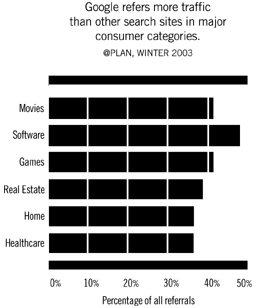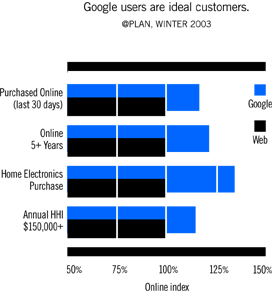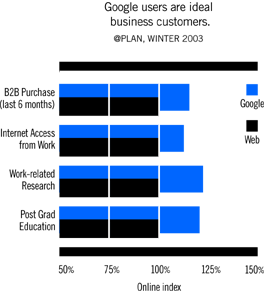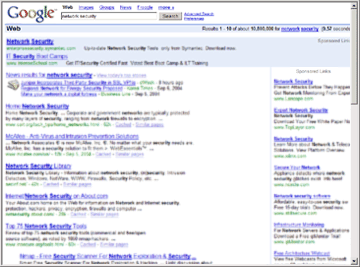An in-depth exploration: why search advertising works
Introduction
Search advertising has finally realized the marketing potential of the Internet.
At first blush, online advertising was a marketer's dream. The Internet seemed the ideal way to reach customers – cost-effective and flexible, offering pinpoint targeting, precise and granular metrics, and an audience empowered to respond instantly to an advertiser's call to action.
But a gap soon appeared between theory and practice. Many marketers, though enthused about the possibilities, were disappointed by the realities of online banner advertising. Declining response rates and unreliable results made forecasting difficult, increasing advertisers' reluctance to structure online into their media plans.
Search advertising is the evolutionary leap that was needed to cross that gap.
Search draws a huge audience of Internet users (only email is used more), each with a specific and active focus, clearly expressed in the search keywords they've entered. The universal need for trusted, relevant Internet search creates an enormous opportunity for businesses to reach with precision people who are actively seeking information at that very moment about the goods and services those businesses provide. In the words of The Wall Street Journal, keyword-targeted ad programs "are finally delivering the benefits that Internet marketers have long been promising from online advertising: measurable results and finely tuned targeting."1
This white paper will examine:
- Why search advertising works
- What you can do with search advertising
- How a Google AdWords campaign is structured
| Why search advertising works |
The power of search keywords
Search-driven advertising is delivered by means of a trigger: keywords. Keywords are the advertiser's window into the customer's thinking – the most important basis for directing an advertising message to precisely those people who want to see it.
A keyword declares a motivation, describes an interest, and implies an intention to take further action – action that will be based on the result of the search that keyword defines. A list of keywords is, in turn, a snapshot of the people who will use them – incomplete, to be sure, but also uncannily accurate in its ability to bring buyers and sellers together.
Just as important, a keyword is the beginning of a conversation between you and your prospective customer. Significantly, this is a conversation that the customer initiates.
How does this work? Let's say someone is doing a search for "polymers," or "German shepherds," or "surgical tools." If an advertiser offering one of those things (or something related to them) has chosen those keywords, their ad appears along with websites that correspond to the user's search.
A responsive audience
The audience thus sees this ad as a response to a question – to which the ad, they quickly realize, provides an answer. At this point, something interesting happens: They become receptive, even enthusiastic. These precisely targeted, pre-qualified prospects become the kind of customer marketers dream about – excited about what's being offered and eager to act on that excitement.
Their responsiveness derives, in part, from the relevance of the ad to their query, which keyword targeting makes possible. It also derives from the setting in which they find it. At which point we have to speak not about search in general, but about Google in particular.
A trusted source
Google, the global leader in search, serves more than 59 million unique visitors each month2 and performs more than one-third of all searches worldwide – more than 200 million per day3– referring more traffic than any other search engine4. Google, the #1 U.S. search engine5, is growing fast, having gained 27 million unique global visitors in just a year6. And Google has ranked highest in consumer loyalty among all online brands for two years running7.
Why do people choose Google instead of some other search tool? Because Google delivers the information people want, quickly and accurately. With the industry's most advanced search technology, Google is the fastest and easiest way to locate relevant information on the Internet. Google's search index contains more than 8 billion web documents8, and gets bigger and better all the time. And because Google refuses to sell its search results under any circumstances, the objectivity of those results is unquestionable.
Google's straightforward, clutter-free pages also deliver information in a form that people can understand and use. The clear distinction in the Google user interface between unpaid search results and paid advertisements (however relevant) adds to the credibility of every element on the page and inclines users to trust what they find there. The objective importance of this clarity was noted by the Federal Trade Commission in its June 27, 2002 response to a complaint by consumer watchdog Commercial Alert against deceptive advertising by search engines — a complaint from which Commercial Alert specifically excluded Google. In a story on the subsequent warning issued by the FTC to the search engines named in the complaint, the Associated Press cited Google as "the only search engine [of 12 they surveyed] that appeared to meet all the criteria laid out by [FTC] regulators" for unambiguous labeling of paid search results, a.k.a. search advertising9.
Why is text more effective?
Further increasing the user's confidence is the format of the ads themselves. Ads on Google are clear, simple text messages, straightforward in their language and without images or animations of any kind – yet Business 2.0 rated Google more effective than any other form of online advertising10. Why do text ads outperform expensive animations and flashy graphics? Because like the rest of the Google interface, they don't try to bludgeon the user into noticing them. Instead, they offer a clear choice in a trusted environment, inviting the user to continue the conversation that began with the initial search query. And users do, at levels so consistently high that 85 percent of current Google advertisers renew11.
Bringing people together
Google's ad programs are founded on the same premise that has made Google search the fastest and most effective way to find information on the Internet: Focus on the user and all else will follow.
The simple fact is that advertising works best when the customer wants to see it – when it answers a question or solves a problem. That's exactly what Google search technology does so well. And that, in turn, is why Google ad programs work so well.
In effect, Google technology makes markets work better. The "invisible hand" that Adam Smith said would guide a market toward an optimal result had a prerequisite: that the actors in that market make their choices on the basis of full and accurate information. Without a way to share that information – transparently and in real time – markets would always fall short of that ideal. In fact, an essential attribute of any successful marketplace – whether of information and ideas or of goods and services – is that people find what they're looking for efficiently, and know what it means once they've found it.
Bringing people, information, and ideas together is precisely what Google does best. Google presents relevant information to search users who ask for it. Some of that information is advertising – but advertising that's fundamental to the overall search experience, advertising that the user wants to see. When you combine relevant search results with relevant advertising, the sum is a superior search experience.
Google's approach means advertisers and search users both find what they want – and that's increasingly true as the number of advertisers, users, and searchable documents on Google increases. All this goes a long way toward explaining why the number of Google users is growing so fast, and why Google advertising is so successful.
| What you can do with search advertising |
Google advertising can feed into your sales cycle in innumerable ways, enabling you to achieve a wide range of objectives for both consumer and business-to-business marketing. A high-level list might include:
- Selling products and services online
- Generating targeted leads
- Testing marketing messages
- Increasing online registrations
- Driving downloads
- Distributing publications
- Promoting special events
- Educating buyers
- Gathering market data
- Building an email database
In business as in our personal lives, we're constantly hungry for information and ideas that can inform our choices. With the advent of the Internet – and the arrival of sophisticated search technologies to make its wealth of information accessible to a global audience – that hunger could be fed with unprecedented ease and effectiveness. Whether the impulse behind a query is frivolous or life-changing, Internet search has become the standard means of finding information. If you doubt it, ask the next 10 people you see when they last used Google.
The ubiquity of search – in every industry and in every aspect of personal and professional life – means you can use search advertising to reach customers across markets and at every point in the buying cycle. Keywords and ad text can be structured to form an ongoing conversation that the customer can enter at any point – from initial awareness to purchase and retention. Besides being the most cost-effective means of customer acquisition, search enables the advertiser to engage the customer – without tricks or intrusiveness – repeatedly and throughout the sales cycle.
Google Users and the Online Marketplace
In part, the extraordinary opportunity that search advertising offers springs from the continued growth of e-commerce. Online general retail merchandise is forecast to grow from $40.7 billion in revenue in 2002 to $146.25 billion in 200712], while the number of online buyers is expected nearly to double over four years13.

This growth is a product of experience. As consumers become more experienced web buyers, they dedicate a greater percentage of their overall spending to buying products online and decrease their offline spending14. And they use search to decide where to spend it. In general, 42 percent of online users use search to shop15. When online shoppers research consumer electronics purchases, for instance, a whopping 61 percent use a search engine to do so16.
Since 84 percent of Google users have been online for more than three years17, it's not surprising to find that Google users rank well above the average online population for every kind of consumer purchase in the last six months – from books to cars, from groceries to electronics, from travel to loans18. In fact, in major consumer categories, Google consistently refers more traffic than other search sites19.

Indeed, the typical Google user is a highly desirable B2C (business-to-consumer) customer – when compared to the average Internet user, for instance 20.

B2B Marketing with Google Advertising
Because Google's global audience includes professionals in every industry, Google advertising works equally well for business-to-business (B2B) marketing. Sixty percent of business decision makers say the web is the best way for advertisers to reach them21. And Google users are 22 percent more likely than the average Internet user to have bought B2B merchandise online in the past 30 days22– a fact reflected in the 10 billion B2B-related search queries Google expects over the next year23]. Indeed, Google was named the fifth most powerful B2B media vehicle – online or off – by BtoB Magazine in its annual Media Power 50 media ranking24.
 |
 |
| How a Google AdWords campaign is structured |
Because advertisers' objectives vary, Google offers distinct advertising approaches to match diverse budgets and strategies. Advertisers can select the placement and pricing options, service levels, and other attributes that best suit their marketing needs. To maximize reach or to meet other marketing objectives, they can also create hybrid campaigns that offers the benefits of multiple approaches.

Placement and pricing
Google AdWords advertising program offers dynamic ad placement with cost-per-click (CPC) pricing.
Placement on Google is usually on the righthand side of the Google search results. (For obvious reasons, the exact placement on Google advertising partner sites will vary.) Pricing based on cost per click (CPC) means you pay only when a prospect actually clicks on your ad – in other words, you pay only for results, not for exposure. Google's cost-per-click model enables you to set and adjust the maximum price paid per keyword, so you can both control your campaign budget and influence your ad position. Because you specify a maximum daily budget – with continuous delivery each day up to a spending limit that you choose – and because rates are set based on market factors and your comfort level, you control both pricing and spend level.
In addition to setting daily budgets and maximum CPC, you choose your own keywords and create your own ad texts. Because you have continuous access to performance reporting tools and can post changes to keywords and ad creative within minutes, you can test and optimize your ad campaign in real time to maximize your campaign performance.
An ad's position on the page is dynamically determined based on a combination of the CPC you've set and your ad's performance, measured by its clickthrough rate (CTR). The result is that more successful ads are given greater visibility, increasing clickthrough and thus improving results.
Service levelGoogle AdWords enables 24x7, hands-on campaign management, with advertisers in direct control of all elements of the campaign – including keywords, ad copy, maximum CPC, and daily ad budget. Changes to your campaign are posted within minutes. Customer support is available via email.
Google advertising partner sitesGoogle AdWords campaigns can also appear on Google advertising partner sites, including America Online, AT&T WorldNet, EarthLink, and Ask Jeeves.
Other features- Reporting. All Google advertising offers 24/7 access
to online reports, enabling advertisers to track and tune their ads
for maximum performance. As a consequence, conversion rates typically
rise in the course of a campaign – a significant departure from
the norm for other advertising media, whose results typically degrade
over time.
- Keyword matching options. Google advertising enables
advertisers to refine their targeting using keyword matching options.
- Broad match, the default, displays an ad when all the
words in the keyword appear in the search query. Broad match also automatically expands matches to display ads for terms related to the keywords, including synonyms and plurals.
- Phrase match requires that the words appear in the same
sequence.
- Exact match requires that the search string and the
keyword be identical.
- Negative keywords exclude searches for which the ad would be irrelevant and are useful in targeting ambiguous keywords: for instance, "mouse –computer" gives you the animal, not the device. High-impression untargeted phrases can thus be identified and included in your list as negative keywords.
- Broad match, the default, displays an ad when all the
words in the keyword appear in the search query. Broad match also automatically expands matches to display ads for terms related to the keywords, including synonyms and plurals.
- Geographic and language targeting. Besides using
geographic keywords to target a local or regional audience, advertisers
can also target their campaigns by country and by language to help
focus their message on its true audience.
- Advertising guidelines and policies. Google's editorial guidelines and competitive policies are designed to improve ad performance and avoid ads that target competitors inaccurately or unfairly.
| Conclusion |
The advertising opportunity offered by Google search is huge – in fact, unprecedented – in its enormous reach, its precise targeting, and its objectively measurable results. Extremely cost-effective at every scale and with nearly unlimited potential for optimization and growth, Google ad programs finally deliver on the promise of online marketing.
| Addendum |
Search advertising campaign checklist
Here's a checklist of issues you'll want to consider as you choose the approach that best suits your objectives and map out your search advertising strategy.
Keywords and targeting- Building and expanding keyword lists
- Organizing keyword groups
- Choosing keyword matching options
- Targeting your campaign by country
- Targeting your campaign by language
- Will keywords be dynamically included?
- What editorial limitations apply?
- How can ad copy be tested?
- Ad position
Where on the page will it appear?
On which pages in a website?
On which sites in an advertising network?
How is ad position determined?
How much and on what basis does it vary?
- Ad delivery: Continuous or aggressive?
- Is your destination page relevant to your ad?
- Are you using navigational options to best advantage?
- Are tracking mechanisms in place to provide the metrics you need?
- How quickly can a campaign be launched? Modified?
- What level of coverage will my keywords provide?
- What level of campaign reporting is available? How frequently?
- What tools are available to optimize your campaign?
Footnotes
2 Nielsen/NetRatings, September 2002
3 Google internal data
4 StatMarket, September – October 2002
5 Nielsen/NetRatings, January 2003
6 Nielsen/NetRatings, September 2002
7 Brand Keys, July 2002
8 Google internal data
9 Associated Press, July 12, 2002, "Search engines not differentiating ads from results" (in USA TODAY)
10 Business 2.0, June 2002
11 Google internal data
12 Forrester, August 2002
13 eMarketer, Q3 2002
14 Forrester, October 2001
15 Jupiter/NPD, May 2002
16 eBrain, May 2002
17 @Plan, Winter 2003
18 @Plan, Winter 2003
19 StatMarket, December 2002
20 @Plan, Winter 2003
21 The Wall Street Journal Interactive, October 2002
22 @Plan, Fall 2002
23 Google internal data
24 BtoB Magazine, May 6, 2002, "BtoB's Media Power 50"

 In-depth look
In-depth look